Eisert 'wedge' 1969-1972 Indy/Formula A car-by-car histories
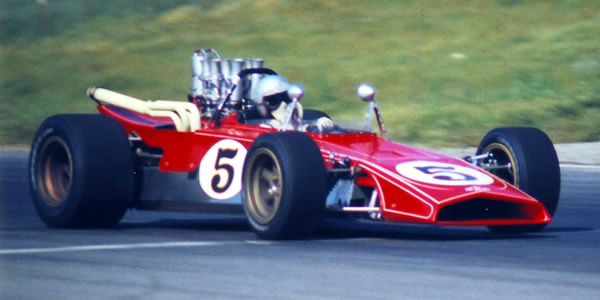
Stew McMillan in his new 1969 Eisert at Riverside in April 1969, his only race start in the car. Copyright Gil Munz 2006. Used with permission.
Experienced mechanic and car builder Jerry Eisert built a series of "convertible" web-shaped cars for Formula A and Indy racing for the 1969 season. Further cars to the same pattern appeared in 1970 and 1972.
Over the winter of 1968/69, Jerry Eisert developed a single-seater intended to be eligible for both USAC racing and the SCCA's fast-growing Formula A category. USAC allowed stock block engines up to 320 cubic inches, while the SCCA allowed similar engines up to 305 cubic inches (5000cc) in FA. The minimum weights were also very similar, at 1350 lbs for USAC and 1250 lbs for Formula A, but the maximum allowed fuel load for Formula A was much lower. This 1969 "convertible" Eisert had a bathtub monocoque along similar lines to his 1965-1968 cars, but with a much squarer appearance and dramatically wedge-shaped bodywork inspired by the Lotus 56. Eisert replaced the rocker-arm suspension that he had used on his earlier cars with twin wishbones and outboard spring/damper units.
In January 1969, he was reported to have ten such cars under construction at his Costa Mesa shop, but only three or four were built. Marvin Webster's team bought one to use in USAC events, mainly on road courses; a second went to Stew McMillen to use in Formula A; and a third was run by Eisert's own team at the 1969 Indy 500 as a test bed for his 202 ci turbocharged Chevrolet engine. Webster's USAC version used 4-speed and 5-speed ZF gearboxes, while McMillen's Formula A version was equipped with a 5-speed Hewland LG600.
Webster's car was always entered as the Webster Special, and was usually driven in USAC events by Jerry Grant in 1969, with a best result of fourth place at Continental Divide in July. Australian Kevin Bartlett drove the Webster-Eisert a few times in 1970, and it continued to appear as late as 1972. Stew McMillen had no luck at all with his Formula A car, and quickly returned it to Jerry Eisert to sell on. Eisert's own car had an even worse record as it never started a race. Al Miller made an attempt to qualify for the 1969 Indy 500 but came in after a single qualifying lap. Eisert returned to the Indy 500 in 1970 with the car, this time with Arnie Knepper driving, but Knepper left the team after only managing a couple of practice laps at 165 mph. Ironically, Knepper ended up in 1967 Gerhardt and narrowly failed to qualify after setting an almost identical time. The Eisert was then run by Kevin Bartlett at Ontario in September 1970, but he also skipped to another team before qualifying started, and although it was entered for the 1971 Indy 500, it failed to arrive.
Four of these cars appeared in 1970, and although one of these would have been the ex-McMillen car, the fourth is likely to have been new. A further car was built to a similar design for 1972.
If you can add anything to our understanding of this car, or have any photographs that we can use, please email Allen at allen@oldracingcars.com.
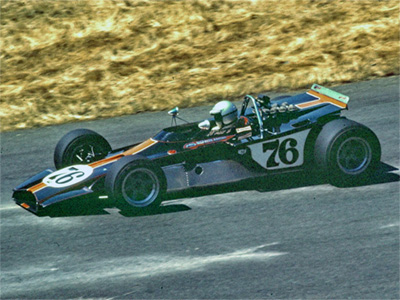
Lothar Motschenbacher in the Webster-Eisert at Seattle in August 1971. Copyright Jim Culp 2017. Used with permission.
New to Marvin Webster's Webster Racing and fitted with Webster's 319 ci stock block Ford V8 engine for Jim Malloy to drive in the California 200 at Hanford Motor Speedway in April 1969. It was later raced by Jerry Grant at Continental Divide, Indianapolis Raceway Park, Seattle and Riverside later that year. He also drove it at Phoenix in November but was too slow to qualify. Kevin Bartlett drove it at Sears Point in April 1970, then failed to qualify at the Indy 500, and later drove it at Continental Divide in June. Rob Grable raced it at IRP in July, after which it was not seen for over a year until Lothar Motschenbacher raced it at Seattle in August 1971, when it was still black with a red stripe, as it had been since new. Ronnie Bucknum tried it briefly in practice at Ontario, and then Johnny Parsons Jr crashed it while trying to qualify at Phoenix. Its last known appearance was when Don Brown drove it at Ontario in 1972, but again no attempt was made to qualify. According to a later Bonhams auction catalogue, the car was then stored by Webster until 1987, when he sold it to Tom Armstrong (Bellevue, WA). Armstrong restored it with a Gurney-Weslake V8 and used it in US historic racing from 1988 to 2003. It was offered for sale from 'the Tom Armstrong Collection' by Bonhams in August 2012, but did not sell. It was displayed at the McCall Motorworks Revival at the Monterey Jet Center in August 2015, and was raced by Jonathan Ornstein (Phoenix, AZ) at the Monterey Motorsports Reunion that same month. It was auctioned again by Bonhams in January 2025 in their Scottsdale sale, described as a "1970 Webster Formula 5000/Indianapolis Single Seater", with Armstrong now described as a previous owner.
Driven by: Jim Malloy, Jerry Grant, Kevin Bartlett, Ron Grable, Lothar Motschenbacher, Ronnie Bucknum, Johnny Parsons Jr and Don Brown. First race: Hanford Motor Speedway (R2), 13 Apr 1969. Total of 10 recorded races.
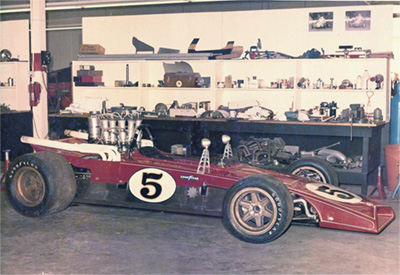
Stew McMillan's 1969 Eisert in his garage in 1969. Copyright Stew McMillan 2004. Used with permission.
Stew McMillan had a brand new Eisert for the 1969 SCCA Formula A season, replacing the 1965 car that he had raced in the US and in New Zealand in 1968. The car was smartly presented in red bodywork and entered as #5. He qualified an impressive eighth at Riverside, the opening race of the Pro season, but retired with an oil leak. He ran again at Laguna Seca two weeks later but after being scalded twice in practice and qualifying he decided "somebody was trying to tell me something", and retired from racing. He took the car back to Eisert and asked him to sell it but still it was still unsold by July, when McMillan picked up the car and ran it for Fred Baker to drive at Brainerd in early August. It then remained in McMillan's garage until Eisert found a buyer for it and Eisert's mechanic arrived to take it away. Subsequent history unknown.
Driven by: Stew McMillen and Fred Baker. First race: Riverside (US R1), 20 Apr 1969. Total of 2 recorded races.
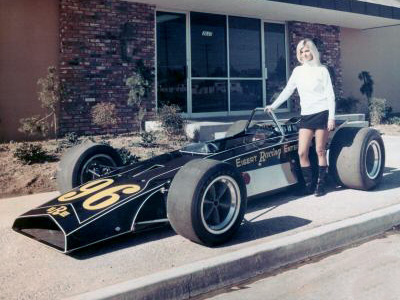
.
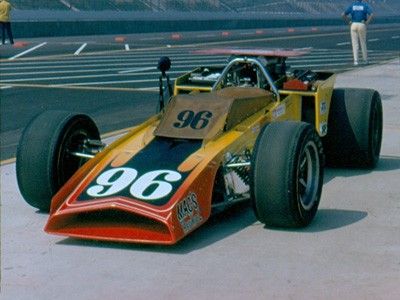
Jerry Eisert's #96 1969 turbo Chevrolet Eisert at Ontario in September 1970. Copyright Gary Critcher 2017. Used with permission.
Fitted with a 202 ci turbocharged Chevrolet V8 engine to be Jerry Eisert's own #96 entry at the 1969 Indy 500, but Eisert was also chief crew for the Friedkin Green team, with their pair of Eagles. The methanol-fueled engine was developed for Friedkin Green by Eisert, with assistance from Chevrolet's Zora Duntov. The car passed its technical inspection on 11 May, and was tested by Friedkin Green driver Jerry Grant and by Bud Tingelstadt over the next few days, but no speed was recorded. The team reported that Grant reached 161 mph, and that Rick Muther later reached 162 mph, which would have been enough for the final row of the grid. On the final day of qualifying, Al Miller started a qualifying run, but came in after one lap when the engine shut off. The Friedkin Green Eagles also used the turbo Chev engine and Grant was similarly unable to get them up to speed. Grant raced Marvin Webster's stock block Eisert at road courses later that season.
The Eisert was next seen a year later at the 1970 Indy 500, still yellow and entered as #96, and still fitted with the turbo Chevrolet engine, but now with slightly modified bodywork. Arnie Knepper managed a couple of laps at 165 mph, which might have been enough for the back row, but made no attempt to qualify. Kevin Bartlett also failed in his attempt to qualify the car for the California 500 at Ontario in September 1970, when it looked much as it had at Indianapolis. The turbo engine expired during practice, so Bartlett drove Lloyd Ruby's backup car instead. The Eisert was on the entry list for the 1971 Indy 500 but did not arrive. Subsequent history unknown.
Driven by: Al Miller, Bud Tingelstad, Jerry Grant, Arnie Knepper and Kevin Bartlett. First appearance: Indianapolis Motor Speedway (R3), 30 May 1969.
1969/70 Eiserts on 1970
The number of wedge Eiserts appears to have increased from three to four in 1970, suggesting Jerry Eisert built another car. However, it is by no means clear cut. Of the three 1969 cars, Marv Webster retained his #76 car for another season of USAC road racing, with Australian Kevin Bartlett taking over from Jerry Grant as driver. Jerry's own Eisert Racing Enterprises #96 car was also retained, but was only seen at the two 500-mile Indy races, at the Indianapolis and Ontario Motor Speedways. The third car had been Stew McMillen's red Formula A car, but he'd returned it to Jerry Eisert for sale.
Two futher such cars appeared in 1970: a red Formula A car driven by Dennis Ott, and a black USAC car that made a single appearance at USAC's IRP race, entered by Mike 'Wolfman' Bohanan. Ott's car is very likely to have been McMillen's, even though Ott entered it as a 1970 car. Bohanan's is less simple to resolve. EIsert's #96 USAC car had been photographed in black bodywork, suggesting Bohanan could have hired it, but all Eisert's have a black mounting plate at the driver's seat bulkhead, and all of these have subtly different patterns of rivets. The plate on Bonahan's car does not match Eisert's #96 car.
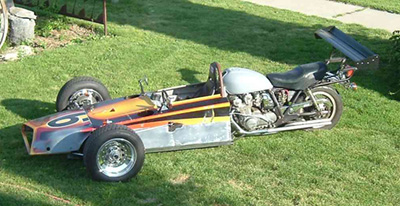
The last known photograph of the ex-Ott Formula A Eisert after the back of the monocoque had been cut away. Copyright Bill Freeman 2014. Used with permission.
Dennis Ott (Montclair, CA/Upland, CA) raced a Eisert in Formula A in 1970. He later advertised the car as a 1970 model, but it looked much like a 1969 model, and may actually have been second hand. At 6'2" and 185 lbs, Ott was large for a racing driver at the time. He came up through modified racing in his home state of Nebraska, then California Racing Association sprint cars in 1967, and then FA in 1970 at the age of 24. He advertised the Eisert in November 1970, describing it as a "1970 wedge style Eisert USAC or F/A" with Hewland LG600 gearbox that had been "road raced nine times". For 1971, he acquired a McLaren M10B, and the Eisert was sold to 29-year-old CAMRA driver Ken Hamilton (Boise, ID), who completed the SCCA drivers school at Seattle International raceway in April 1971 and drove the Eisert in SCCA Regional and National races that season, as well as the USAC road-racing event at Seattle in August. In 1971 he was considering having Jerry Eisert convert the car to use in the 1972 Indy 500, but nothing came of this. He was entered for the Laguna Seca and Edmonton Pro F5000 races in early 1972, but there is no record of his participation in either event. He focused on CAMRA and MRAO (Modified Racing Assn of Oregon) racing in 1972, driving for Art Sugai, and had a very successful season. The car was sold by Hamilton to Lonnie Knigge (Salt Lake City, UT), to use in Super-Modified racing, but the ex-Ott car had been joined by the 1972 Eisert at some stage, and which one Knigge raced is unclear. Knigge sold both Eiserts to Bill Freeman (Colerain, NC), and he sold the ex-Ott car in 1982 to Wes Brunner (Salt Lake City, UT). It was then modified by cutting away the back of the monocoque and attaching a motorcycle rear end. The fate of the resulting vehicle is unknown.
Driven by: Dennis Ott and Ken Hamilton. First race: Riverside (US R1), 19 Apr 1970. Total of 11 recorded races.
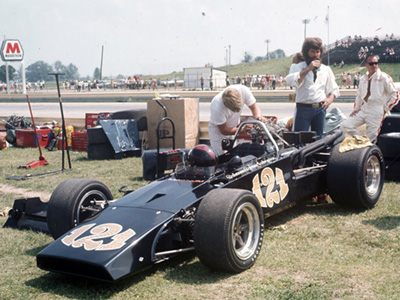
Mike 'Wolfman' Bohanan standing behind his FA Eisert at IRP in 1970. Copyright Tom Schultz 2006. Used with permission.
Michael Bohanan entered a 1969-shape Eisert with Chevrolet V8 engine for Scooter Patrick to drive in the USAC race at Indianapolis Raceway Park in July 1970. The car was plain black, and entered as #121 by Bohanan Racing Enterprises. Mike Bohanan was a well-known character in the Los Angeles area, where he was one of the founders of the "Banzai Runners" who raced their cars around the Los Angeles freeways at the start of the 1970s. His name is variously recorded as Mike Bohannan or Mike Bohannon, but a photograph of his car at IRP clearly shows the spelling Bohanan. Patrick qualified the Eisert respectably, but was eliminated from the race in an accident with Mario Andretti and Ronnie Bucknum. The Eisert was not seen again, and its fate is unknown. A year after this, Bohanan acquired a Lola T70 Mk 3B that had been converted by Roger Penske to be road legal, and continued his exploits on the road.
Driven by: Scooter Patrick. First race: Indianapolis Raceway Park (R9), 26 Jul 1970. Only one recorded race.
The 1972 short wheelbase Formula A Eisert
A further Eisert Formula A car built to much the same pattern was "new" in 1972, although its chassis may have been built earlier. It was first recorded in April 1972, when Marv Webster (Mill Valley,CA) advertised two Webster-Eiserts: his regular USAC car plus a "brand new never run" Formula A car with 92-inch wheelbase, significantly shorter that the 98-inch wheelbase on Stew McMillen's 1969 Formula A Eisert.
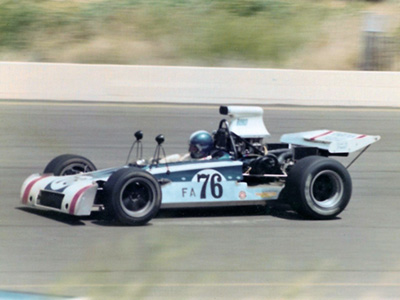
Hunter Harris in his Eisert. Copyright Vincent Puleo 2020. Used with permission.
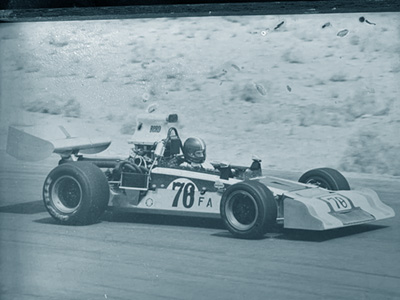
Hunter Harris in his Formula A Eisert in late 1975 or in 1976, seen here with its new nose and new rear wing. Copyright Hunter Harris 2025. Used with permission.
A new 1972 "Webster/Eisert Formula A chassis" with 92-inch wheelbase advertised by Marv Webster (Mill Valley,CA) in April 1972. Sold to John Kuenzli (Reno, NV) who intended to run the car for Gary Burke to drive in Formula A, but its first event showed that it was not set up properly for road racing. After some time redeveloping the car, Kuenzli and Burke returned with the "Webster/Lizard-1972" for L&M F5000 Championship race at Laguna Seca in May 1973, where it was entered as the "RNR Special". The rest of the pit crew comprised Kuenzli's wife Marilyn, engine builder Bob Santolini, body man Mike Peart, and Burke's wife Rosemarie. Burke qualified 32nd, slowest of all those that set a time, 23% slower than the leading Lola T330s, and was the first retirement. He also drove the car at the Laguna Seca June Sprints seven weeks later. The car was later found hanging on Bob Santolini's shop wall in 1974 by Hunter Harris (El Macero, CA/West Sacramento, CA), a friend of Burke's. He raced the car in local SCCA Formula A in California in 1975, but found its ZF gearbox was still geared for very high speeds. He changed it to a Hewland DG300 for 1976, when he also fitted a new nose and a single mount rear wing. When Harris bought a Talon later in 1976, he sold the Eisert to someone in Monterey, CA. This is likely to have been Bill Moir (Salinas, CA), who bought such a "Spartan Machine in Sacramento CA around 1978". The date and location match, as Carmichael is a suburb of Sacramento, and Spartan Engine Development & Machine Work was Bob Santolini busines in West Sacramento. David Pozzi (Salinas, CA) drove the car in a Solo event while Moir owned it. He remembers that Moir, who moved to Oregon and became well-known as a restorer of Can-Am McLarens, sold it during the 1980s. Somehow the car reached Kenny Hamilton (Boise, Idaho), joining the ex-Ott car that he already owned. Both Eisert's were sold by Hamilton to Lonnie Knigge (Salt Lake City, UT), to use in the Super-Modified class. He raced one of them for a single season but then quit racing. Knigge sold them to Bill Freeman (Colerain, NC), who understands that Knigge acquired them in the late 1970s. Freeman sold the ex-Ott car in 1982 but retained the ex-Kuenzli /Burke car, still recognisable in Freeman's photos in the same livery and with "paint by Peart" on the rear wing. Sold by Freeman to Toney Edwards (Indianapolis, IN) in 2017. Still with Edwards in April 2025.
Driven by: Gary Burke and Hunter Harris. First race: Laguna Seca, 26 Aug 1972. Total of 10 recorded races.
Acknowledgements
My thanks to Wolfgang Klopfer who initially researched these cars in 2001. Thanks also to Stew McMillen, Bill Freeman, Hunter Harris, David Pozzi and Toney Edwards for information on the Eiserts that they have owned.
If you can add anything to our understanding of this car, or have any photographs that we can use, please email Allen at allen@oldracingcars.com.
These histories were last updated on .